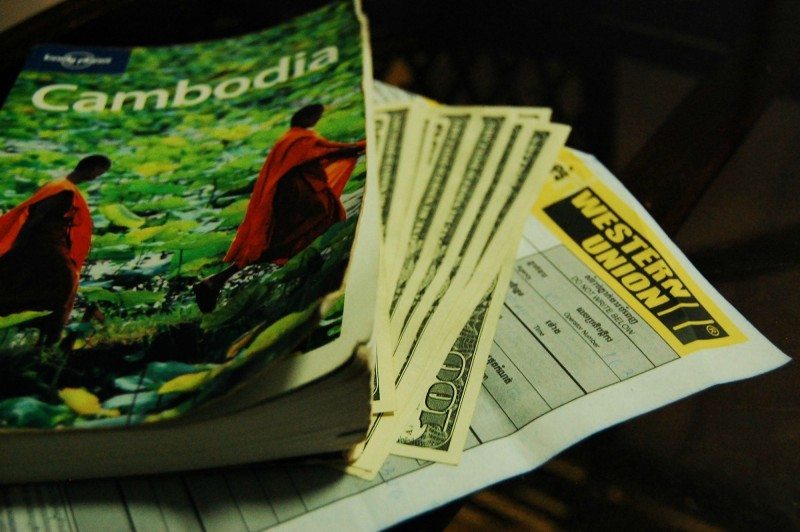Every travel blogger has written about how to save money and pay down credit card debt at one time or another, and now it’s my turn. People are constantly asking the question, “How can I travel when I have so much debt?” And the answer isn’t easy. I’ve traveled the world, and I’m not even debt-free! I still have $465 a month in student loan payments I have been dutifully making for the past decade. At this rate I will still be making those payments for another six years.
But that doesn’t mean I can’t afford to travel. It just means I have to budget more carefully and save more money if I want to be away from work for longer. But student loans are a kind of debt most twenty- or thirty- somethings have these days.
What about that other kind of debt? The kind with often soul-crushing interest rates? That’s right, I’m talking about credit card debt.
Sadly, our current financial system encourages 18 year-olds in college without a job to sign up for several credit cards in order to “build their credit.” And building credit is certainly important. But handing over credit cards to financially uneducated teenagers probably isn’t the best system out there. So if traveling is what you want to do, but you just can’t afford to while you’re paying off $5,000, $10,000 or even more in credit card debt, here are some tips to help you do it faster.
All of these tips also apply to saving money, but obviously you need to pay off that high interest debt first, and then you can start squirreling all of your extra cash away!
10. Learn How Much You Spend on Everything
This may seem like a no-brainer, but you would be surprised how many people don’t even know where their money goes every month! Payday comes and suddenly it’s all gone and there’s still another week before your next paycheck! If this is you, then it’s time to start tracking EVERY DAMN CENT. It’s impossible to save money before you know what you’re spending it on in the first place. I have a spreadsheet where I enter every single penny I spend, and then apply it to different categories each month to see how my spending has changed.
You can access this google spreadsheet for free right here! The best part is you can play around with your spending and saving to see how much faster you can be out of debt!!
9. Make a Budget, and Then Stick To It
Again, sounds obvious, right? But making budgets and sticking to them are two totally different things. I put all of my expenses on a credit card and pay it off in full at the end of every month. But that takes daily tracking to know if I’m approaching my spending limit in a certain category. You can use an online financial tool like Mint to track your accounts and it will even send you an alert if you’re approaching your budget in a certain category. This works great if all of your charges are on a debit or credit card, but if you’re already in a bunch of credit card debt, you may have trouble controlling yourself while using a card. Luckily, there is a solution!
8. Become a Cash-Only Spender
All the times in my life I’ve been truly poor (which have been numerous) I’ve moved to a cash-only basis. Rather than tracking every penny I spend by category, I simply allot a certain amount for each week, take it out in cash, and then that’s it. If I run out of that cash, I don’t get to buy anything else the rest of the week. If you’re truly trying to save money, this is THE BEST WAY TO DO IT. Studies have shown that spending on credit and debit cards means spending more than when we use cash. You are much more conscious of cash leaving your wallet than the same amount of $ leaving your bank account through your debit card. It’s a fact.
7. Stop Shopping
If I really have to tell you this, then we’re in real trouble. But if you are in credit card debt from buying clothes or electronics or shoes or anything else, CUT IT OUT. Cut up your cards and never look back. To give yourself some perspective, go back and add up every single thing you bought in the last 12 months. Look over the last year and you might be shocked to find out how much you spent. That shock can be a good tool to jar you into changing your habits.
6. SAVE FIRST, Then Spend
Most people think of savings as “the money I have leftover after I pay my bills and live for a month.” But what if your savings IS a bill? What if it’s an expense you have to pay every month? When you put away your savings first, then there is never a temptation to spend it because you don’t have access to it. If you’re paying down credit cards, then this is the same principle. Pay a set amount that is the most you can possibly pay at the beginning of the month. Then when you run out of money, and your cards are all cut up, you don’t have the option to keep spending.
For a long time while I was off the grid, my savings account was a piggy bank I counted each night after work. I worked in a bar so coming home with cash was the standard. I put in $50 every night I worked no matter what. If I made $70, I still put in $50. If I made $150, I still put in $50. If you get paid via direct deposit like most people, then set up an auto-draft that comes out the same day as your paycheck goes in. You will never even get to see the money and trust me, when you start saving or paying off debt first, it adds up so much more quickly!
5. Now Cut Out More, and Save Even More
When reading the last two tips you may have thought, but Taylor, after my bills and living expenses there isn’t anything left to save! How can I save money I don’t have??? Well, in some cases if you’re really struggling, this might be true. And in that case, I’m sorry, and we need to raise the minimum wage, and it’s a travesty how many people work full time jobs and still can’t afford to live in the U.S. But, most likely you are not living on or below the poverty line, and you just haven’t taken the time to adjust your standard of living.
If you followed the first step, then you should know exactly how much you’re spending. Now, trim the fat. The most popular anecdote is, “A cup of coffee every day can mean $100 extra a month.” This is a great place to start. But think about other things. What about your $10 Spotify subscription every month. Could you live with listening to ads? Yup. What about your premium TV channels or your extra large phone plan with unlimited data? What about that magazine or candy bar you impulse-bought last week? None of these things are necessities, but they all seem small enough as to not make a huge difference. Trust me, they make a huge difference. Until you truly understand how much every penny matters, you’ll never be able to maximize your savings.
4. Analyze Your Eating
There’s no doubt about it, we all need to eat. But you could be spending a lot more on groceries than you need to be because you simply never thought about it before. People say on average a single person should spend around $200 a month on groceries. And that’s a pretty good estimate to eat well and healthy and have a nice variety. But if you’re really ramping up into super-saver-debt-paydown-mode then you can easily adjust your eating habits to find an extra $50 a month.
Shopping for bargains at the store, using coupons, and buying things on sale are all great ways to trim some fat. Don’t forget buying generic and paying close attention to price per ounce vs. overall price. Love to eat bacon every weekend? Try to cut it down to once every other week. Love having steaks? Me too, but I never do because I hate paying so much for dinner when chicken is so cheap. Eat what’s local and cheap and in season and most of all, always be aware of what you’re spending. If your budget is $40 per week, then don’t spend more than $40! If you hit your limit, go grab some ramen. It may not be healthy, but it’s $0.25 and can replace a few meals in a bind.
3. Downsize Your Life
This is certainly one of the harder ones to implement, and it doesn’t apply to everyone. But if you’re stuck in a bunch of credit card debt you can’t seem to pay off, you may be living above your means. It’s a trap many people fall into, as soon as they make more money, they increase their standard of living. They buy a nicer car with a higher monthly payment, they move into a nicer apartment downtown. If you have done any of these things, take a step back and ask if you really need them, or can afford them. It is a big move to make, but if your rent is more than 30% of your income (and you don’t live in San Francisco) it’s too much. If you struggle to make your car payment and pay all your bills every month, it’s too much.
There is a level of living lower than what you’re accustomed to that is still perfectly fine, I promise. You don’t need a nice car, just one that gets you to work. You don’t need a fancy apartment, just one with heat in the winter and a place to put your things. Sadly, American culture places an extremely high value on the ownership of newer and nicer things. The sooner you realize that our culture is what’s stopping you from paying off credit card debt, and what got you into this mess in the first place, the sooner you’ll be able to break free from it.
2. Stop Going Out
OK, obviously if you’ve analyzed your spending and found out you’re dropping $300 a month at bars and restaurants, you should have already scaled this back. But going out can be one of the hardest things to give up. It’s how we socialize, it’s where we meet our friends, it’s how we unwind after a hard day of work. And leaving that social support net to sit at home is TOUGH. Especially when you’re working so hard to save and feel like you deserve a treat or a night out.
Honestly, there isn’t a good way to stop doing this except to stop. Until saving is more important to you than going out, you’ll always end up spending more money that you could have been saving. But once you start actually saving and you can watch those numbers grow, you may actually care more about saving than about that happy hour! It’s magical when it happens, and once it does, you’ll never be tempted to buy a $10 martini again.
1. Plan Your Dream
If you’re stuck with hundreds of dollars a month in credit card payments and hundreds in student loans on top of that, it can feel like there isn’t an end. Trust me, I’ve been there. I was making over $60,000 a year and STILL couldn’t seem to save money! Obviously that’s crazy and I needed to adjust my lifestyle and focus on paying down debt and giving up my online shopping habit. It can be hard to motivate when there doesn’t seem to be an end in sight. But motivation can be easier when you’re working towards a specific dream rather than just “pay down credit card debt.”
If you’re on this website, then your dream probably has something to do with travel. So plan it! Plan your round-the-world trip even if it’s going to take you five years to save up enough to do it. Saving is hard, and limiting spending on things we’re used to is even harder. But just think, once your credit card is paid off, you’ll have a couple hundred dollars more to save every single month! And the more you can save, the closer that trip becomes.
So plan a trip, get a poster of where you want to go and hang it above your desk. Anything to remind you why you’re working so hard in the first place. I have a good friend who spent two years working TWO full time jobs to save enough to travel the world. And those two years were hell. But it was all worth it in the end when he attained the financial freedom to follow his dreams around the world.









